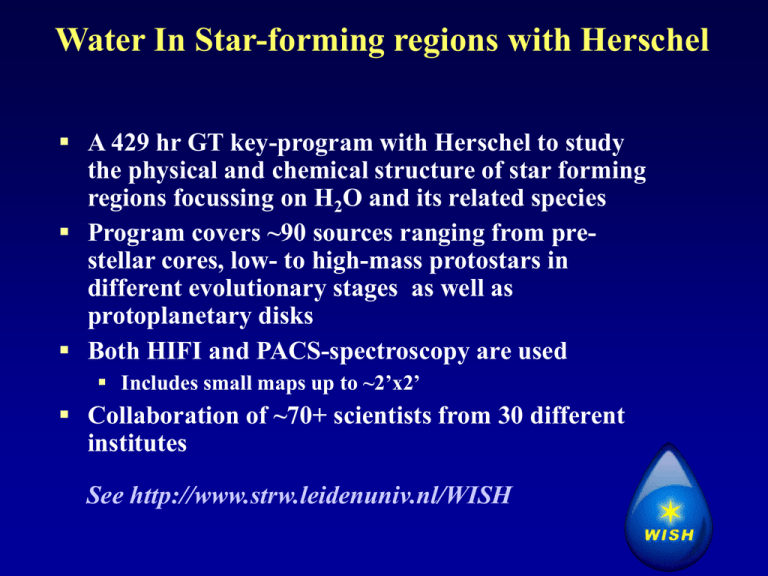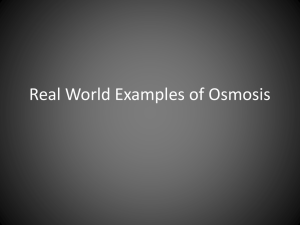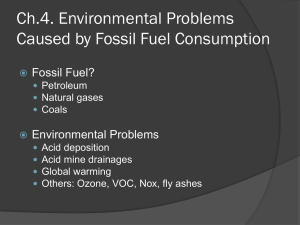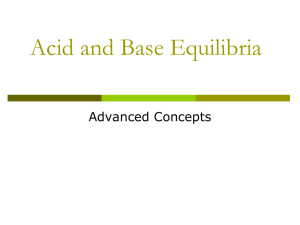H 2 O lines
advertisement

Water In Star-forming regions with Herschel A 429 hr GT key-program with Herschel to study the physical and chemical structure of star forming regions focussing on H2O and its related species Program covers ~90 sources ranging from prestellar cores, low- to high-mass protostars in different evolutionary stages as well as protoplanetary disks Both HIFI and PACS-spectroscopy are used Includes small maps up to ~2’x2’ Collaboration of ~70+ scientists from 30 different institutes See http://www.strw.leidenuniv.nl/WISH Follow water trail during star and planet formation D. Lommen Dark pre-stellar cores Low-mass YSOs Disks Intermediate mass YSOs Infrared dark clouds High-mass YSOs Why water? H2O abundance shows large variations in SF regions: <10-8 (cold) – 3. 10-4 (warm) unique probe of different physical regimes Natural filter of warm gas Main reservoir of oxygen affects chemistry of all other species Traces basic processes of freeze-out onto grains and evaporation, which characterize different stages of evolution Astrobiology: water associated with life on Earth characterize water ‘trail’ from clouds to planets, including origin of water on Earth pre-stellar cores YSO’s disks comets H2O lines: HIFI vs PACS Red: HIFI Blue: PACS Observe mix of low- and high-excitation lines to probe cold and hot environments First results letters submitted HH 46 PACS: van Kempen, Kristensen et al. NGC 7129 PACS: Fich et al. L1157 outflow PACS: Nisini et al. DR 21 HIFI: van der Tak et al. Highlight L1157-mm outflow D = 440 pc, Lbol = 11 Lo 3’ Nisini, Liseau, Tafalla, Benedettini et al. Water traces ‘hot spots’ where shocks dump energy into cloud SDP/PSP HIFI data received Pre-stellar cores: B68, L1544 Low-mass YSOs: NGC 1333 I2A, I4A, I4B: many lines but 557 GHz not taken Other sources: 557 GHz only Outflows: none Intermediate mass: NGC 7129 some lines High mass: some SDP/PSP sources Rad. diagnostics: W3 IRS5 Disks: deep DM Tau, shallow: BP Tau, HD163296, AS209 Problems? Instrumental Some minor issues Otherwise data quality ‘perfect’ (rms close to expected) Waiting for mapping mode release Scheduling Random: some sources observed in some lines, others in others difficult to get consistent set of lines even for small sample of sources several SDP and PSP-1 not executed before sources disappeared from visibility Software Some use HIPE, most use CLASS Automatic data pipeline produces good quality data + CLASS files: WISH Live data show (thanks to Umut Yildiz + Erik Deul) WISH-team E.F. van Dishoeck, Y. Aikawa, R. Bachiller, A. Baudry, M. Benedettini, A. Benz, E. Bergin, P. Bjerkeli, G. Blake, S. Bontemps, J. Braine, A. Brandeker, S. Bruderer, P. Caselli, J. Cernicharo, L. Chavarria, C. Codella, F. Daniel, C. Dedes, P. Encrenaz, A.M. di Giorgio, C. Dominik, S. Doty, H. Feuchtgruber, M. Fich, W. Frieswijk, A. Fuente, T. Giannini, J.R. Goicoechea, Th. De Graauw, F. Helmich, F. Herpin, G. Herczeg, M. Hogerheijde, T. Jacq, J. Jørgensen, D. Johnstone, A. Karska, M. Kaufman, E. Keto, L. Kristensen, B. Larsson, B. Lefloch, D. Lis, R. Liseau, M. Marseille, C. McCoey, G. Melnick, D. Neufeld, B. Nisini, M. Olberg, G. Olofsson, L. Pagani, O. Panić, B. Parise, J. Pearson, R. Plume, C. Risacher, D. Salter, N. Sakai, J. Santiago, P. Saraceno, R. Shipman, M. Tafalla, F. van der Tak, T. van Kempen, R. Visser, S. Viti, S. Wampfler, M. Walmsley, F. Wyrowski, S. Yamamoto, U. Yildiz (blue indicates subteam leader; yellow project scientists) Those who did the work to make this presentation possible…. E.F. van Dishoeck, Y. Aikawa, R. Bachiller, A. Baudry, M. Benedettini, A. Benz, E. Bergin, P. Bjerkeli, G. Blake, S. Bontemps, J. Braine, A. Brandeker, S. Bruderer, P. Caselli, J. Cernicharo, L. Chavarria, C. Codella, F. Daniel, C. Dedes, P. Encrenaz, A.M. di Giorgio, C. Dominik, S. Doty, H. Feuchtgruber, M. Fich, W. Frieswijk, A. Fuente, T. Giannini, J.R. Goicoechea, Th. De Graauw, F. Helmich, F. Herpin, G. Herczeg, M. Hogerheijde, T. Jacq, J. Jørgensen, D. Johnstone, A. Karska, M. Kaufman, E. Keto, L. Kristensen, B. Larsson, B. Lefloch, D. Lis, R. Liseau, M. Marseille, C. McCoey, G. Melnick, D. Neufeld, B. Nisini, M. Olberg, G. Olofsson, L. Pagani, B. Parise, O. Panić, J. Pearson, R. Plume, C. Risacher, D. Salter, N. Sakai, J. Santiago, P. Saraceno, R. Shipman, M. Tafalla, F. van der Tak, T. van Kempen, R. Visser, S. Viti, S. Wampfler, M. Walmsley, F. Wyrowski, S. Yamamoto, U. Yildiz Pre-stellar cores in WISH PLAN: observe H2O(110-101) to measure the initial content of water vapor in star forming regions before stars are born, as a function of environmental conditions Original Total time: 20h (Italy) + 2h (Spain) Team: Paola Caselli (leader), Yuri Aikawa, Ted Bergin, Eric Keto, Laurent Pagani, Mario Tafalla, Floris van der Tak, Malcolm Walmsley + Brunella Nisini, Claudio Codella (Italian representatives) Two sources observed so far Tmb(K) L1544 MODEL (MOLLIE) V-VLSR (km/s) Maximum (undepleted-undissociated) H2O abundance = 510-9, from the lowest upper limit found in dark clouds (<710-9; Harju et al. 2009). Data convolved with Herschel beam at 557 GHz. Should be (0,0) Non detection consistent with x(H2O) < 10-9 at n(H2) = 105 cm-3, T = 10 K and v=0.5 km/s or x(H2O) < 10-8 at n(H2) = 104 cm-3, T = 10 K and v=0.5 km/s Low-mass YSOs: NGC 1333 p-H2O ground-state line outflow Absorption in outer envelope H218O detected: broad lines Kristensen, Visser et al. in prep Warm H2O in photon-heated outflow walls? p-H2O Excited line Comparing CO and H2O Yildiz et al., In prep Which physical component dominates which lines? Modeling by Visser, Kristensen, Bruderer PDR Disk Protostellar envelope with hot core: Low-J CO UV irradiated cavity walls, disk surface: Mid-J CO Hot water? Outflow shocks: High-J CO, Hot water? High velocity O I Intermediate mass YSO program Johnstone, Fich, McCoey et al. - Good data, planning O.K. High-mass star formation Outline of program Abundance + distribution of H2O in envelopes: pointed HIFI obs of 13 lines in 19 sources Water in massive outflows: 557 GHz mini-map Kinematics and geometry of warm inner envelopes: PACS spectro-imaging of CO, O, OH, H3O+, high-J H2O F. deep Herpin, L.557 Chavarria, Bontemps, A. Baudry, J. Braine, HIFI GHz obsS.of four infrared-dark cloud cores T. Jacq (Bordeaux) Chemistry of massive pre-stellar cores: Filling, cooling & chemistry of intra-cluster gas: F. van der Tak, M. Marseille, W. Frieswijk, F.P. Helmich, R. Shipman (Groningen) 5-10 arcmin2 HIFI + PACS maps in 4 lines of 6 proto-clusters F. Wyrowski, (Bonn) Bits + pieces of PSP1+2 done Are the scientific goals reached ? • In progress, but very promising !! ⇒ 3 papers to be submitted to the HIFI special issue of A&A. + 1 paper submitted to the A&A HSO special issue • Lines are well detected with a lot of informations coming from the velocity profile (thanks to the HRS !!) • New detections: H2O+ H2O 110-101 in prestellar core G11.11 SCUBA-P1 G34.26: H2O+ line in red (water in black) H2O 202-111 in W3IRS5 H2O 111-000 (HRS spectra with continuum) G31.41 G29.96 NGC7538IRS1 G34.26 W33A WBS W3IRS5 self-absorbed saturated lines reaches exactly the level of 0 K of the profile ⇒ continuum calibration in HIFI observations is correct Predicted by models of water ground-state emission lines, in the case where XH2O ~ 10-8 , i.e. high abundances. W43MM1 WBS This is particularly visible in G31.41+0.31, a HMC, but also detected in other HMC sources, where having this high abundance of water makes perfectly sense. Radiation Diagnostics Arnold O. Benz Simon Bruderer Pascal Stäuber Susanne Wampfler Carolin Dedes Ewine F. van Dishoeck Zurich Institute of Astronomy, Star and Planet Formation Group `New‘ molecule: OH+ Source Vel. = 0 OH+ also detected from ground by APEX (Wyrowski et al. 2010) New molecule: H2O+ `New molecule‘: SH+ SH+ also detected from ground by APEX (Menten et al. 2010) Hydrides in High-mass Star Forming Region CH NH SH+ OH+ Chemical Network of Water in Gas Phase OH+ H2 H+ He+ OH H2O photon H+ H2O+ H2 HCO+, H3+ H2 Bruderer et al. 2010 H3O+ ee- H2O+ detected in the ISM: the fourth `phase‘ of water H2O+, OH+, CH+, and SH+ are the paint on the outflow wall Radiation Diagnostics Summary 1. Molecules under UV irradiation (and X-rays?) in high-mass objects detected as hoped 2. `New‘ molecules: H2O+, OH+, SH+ 3. Not as predicted: line shape, velocity shift, absorption/emission 4. Most ionized molecules more intense than predicted • • • • Disks To detect cold water vapor in protoplanetary disks Sample • • • well studied objects with gas-rich disks 4 ‘deep’ targets: DM Tau, LkCa15, TW Hya, MWC480 8 ‘shallow’ targets: BP Tau, AS209, HD163296, IM Lup, GG Tau, MWC 758, T Cha, GM Aur o-H2O 110-101 to 3σ=4.5 mK (15 mK) in 0.5 km/s p-H2O 111-000 to 3σ=12 mK (44 mK) in 0.5 km/s Michiel Hogerheijde, Carsten Dominik, Ted Bergin, Geoff Blake, John Pearson, Gary Melnick, Dave Neufeld, Darek Lis, Olja Panic, Christian Brinch, Ewine van Dishoeck, Lars Kristensen, Umut Yildiz, José Cernicharo Disks: upper limits DM Tau HD163296 BP Tau AS 209 Disks: DM Tau vs models DM Tau o-H2O 110-101 Models predict line intensities of a few to several tens of mK. Observations rule out some models. Comparison to amount of ‘warm’ CO (e.g., CO 6-5, ~80-100 K) and CI may be essential to see if DM Tau p-H2O 111-000 – disks lack warm gas – warm gas in disks is ‘dry’ – water vapor at low T is ‘dark’ Now that it seems that disks are ‘dark’ in the ground state lines, consider to focus on a higher excitation water line. Conclusions WISH program and approach generally validated Balance HIFI-PACS lines largely O.K. (see also Kristensen talk), but minor tweaks needed as analysis progresses E.g., more highly excited H2O lines









